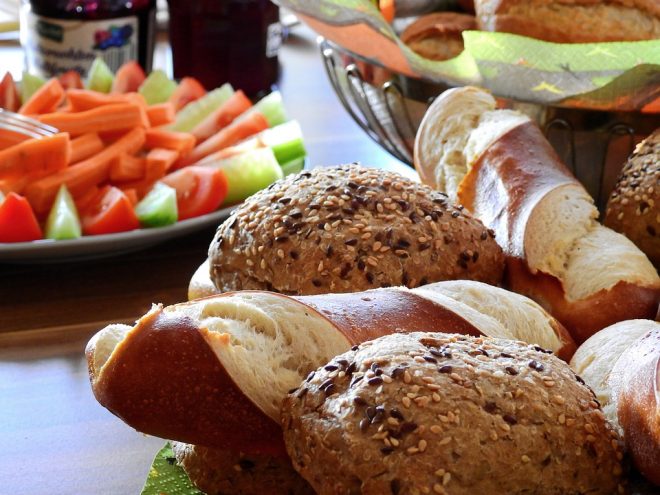Could consuming insects help solve the world hunger crisis? Yes, says Flying Spark, an Israeli startup whose fruit fly larvae protein powder is said be more sustainable than traditional livestock farming, more nutritious than animal protein and more environmentally-friendly than the greenhouse gas emissions associated with livestock.
The issue of world hunger and the idea of using insects as a source of protein was what motivated entrepreneur Eran Gronich to seek out insect specialist Dr. Yoram Yerushalami in 2014 to create a solution to help the 795 million people facing hunger around the globe. According to the World Food Programme, 1 in 9 people around the world go to bed hungry.
SEE ALSO: Bug Grub: Israeli Startup Flying Spark Breeds Protein-Rich Edible Insects to End World Hunger
Flying Spark, which hopes to “fill 9 billion bowls by 2040,” has raised $1 million in the span of a year and is on the fast track to going commercial by the fourth quarter of next year. They have also moved forward with establishing the infrastructure of their R&D center in Israel and with the production line that processes the larvae. According to CEO Gronich, the company is in the midst of raising several million dollars in the post seed round.
Collaborating with IKEA
Flying Spark’s mix of sustainable protein and innovative technology has earned support from The Kitchen, a food-tech incubator sponsored by the Strauss Group (one of the largest food conglomerates in Israel) and the Israel Innovation Authority. It also currently works with Grupo Bimbo, the world’s largest baking company, located in Mexico City.
The company hit another huge milestone this year when it was accepted to the IKEA Bootcamp startup accelerator. More than 1,200 applications from 86 different countries applied to join the Bootcamp, but only 10 startups were accepted, Flying Spark being one of them. It will join the IKEA Bootcamp at the IKEA product development center in Sweden on September 18, 2017 for a 3 month program.

Ikea Store via Pixabay
“When a giant like IKEA believes in us, it’s a big honor for us,” Gronich tells NoCamels. “For us, it’s a huge opportunity.”
SEE ALSO: These Israeli Companies Fight World Hunger With Innovative Technologies
“The FAO (Food and Agriculture Organization of the United Nations) predicts the world population will rise to 9 billion by 2040 and there will be 2 billion extra mouths to feed. These are two billion extra people using the same methods that we use today,” Gronich explains. “Once we have our state-of-the-art facility — each facility is producing thousands of tons of protein powders per year — then we will be able to incorporate it into all kinds of food products and be able to lower the amount of steaks and burgers people are eating. The more people eat insects, the less people will eat meat. Traditional livestock farming is not sustainable.”
Gronich hopes the retailer will not only be a mentor to the team, but will also collaborate with them to develop and launch insect protein-rich food products in their 389 restaurants around the world.
Sign up for our free weekly newsletter
SubscribeWould you eat insect protein at IKEA?
“There are about 2 billion people around the world who are already eating insects as part of their daily diet,” Gronich explains. “All of us, we are eating insects and we don’t even know it. It’s the best protein you can get.”
Fruit fly farming requires very little water and no land. The flies harvest themselves and most of their gut content is purged as part of their short life cycle. Fruit flies are a highly rich source of iron, calcium and magnesium and an exceptional profile of amino acids. They are free of cholesterol, antibiotics, and hormones.
From a business angle, replacing animal protein with insect protein is durable and cost effective. It is easy to ship around the world and cheap to produce because the lifespan of the larvae is only 6 days.
In short, the pros of eating insect protein far outweigh the cons.
“We are not serving you the larvae on your plate. We are turning it into powder. Our business model and our strategy is to sell it to traditional, regular food manufacturers,” says Gronich.
The powder is created through a machine that has units to form the larvae and process it into a powder. The larvae is boiled and ground, protein is separated from the fat, and then the protein is dried and turned into a powder.
The powder is sold to manufacturers, who would then incorporate it into their food products.

These foods could contain insect protein one day via Flickr
People don’t even know they are eating insects. “We’ve made food products just to prove we can make anything out of this material. We’ve made bread, pasta, cereal, cookies, tortillas –meat replacements without killing cows and even milk replacements that have more calcium than regular milk,” Gronich says.
Photos: Robert Eede, Christian, Mastrminda
Related posts

Resilient And Nutritious New Plant-Based Milk Aims To Make A Splash

Chocolate From Cultivated Cocoa Comes Without Environmental Toll

Plastic Fantastic: Startup Takes PVC Back To Its Crude Oil Roots




Facebook comments